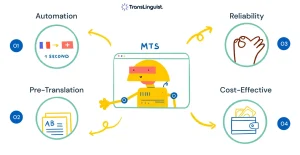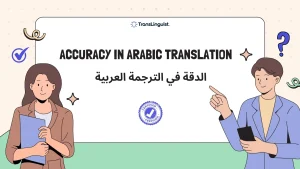AI is transforming the way document analysis is conducted, making it faster, more accurate, and highly efficient. With advancements in Optical Character Recognition (OCR), Natural Language Processing (NLP), and Machine Learning (ML), businesses can now automate document processing tasks that traditionally took hours or even days. AI-driven solutions have become indispensable in sectors like legal, healthcare, finance, and translation services, with TransLinguist at the forefront of this revolution.
What is AI-Powered Document Analysis?
AI-powered document analysis refers to the use of advanced technologies to automate the extraction and understanding of information from documents. It significantly improves accuracy and speed compared to manual methods. This is particularly important for industries that handle large volumes of paperwork. By integrating AI, TransLinguist ensures that clients benefit from high-speed, high-quality results.
One of the key technologies used is Optical Character Recognition (OCR). This technology converts scanned documents and images into editable text formats, saving time and reducing manual labor. For instance, OCR can process invoices, contracts, or legal documents swiftly, minimizing human error and ensuring that important details are accurately captured. The use of OCR is especially beneficial in Document Translation, allowing TransLinguist to handle large-scale projects with ease.
Natural Language Processing (NLP) is another core component of AI-powered document analysis. NLP enables machines to understand, interpret, and manipulate human language. In document analysis, NLP helps extract insights from unstructured text, making it valuable for fields like legal translation and compliance documentation. NLP is widely used in Remote Simultaneous Interpretation, helping interpreters deliver accurate translations in real-time.
Machine Learning (ML) plays a significant role in improving document analysis over time. ML algorithms can learn from past data to improve the accuracy of predictions, such as identifying patterns in document classification or categorization. This constant learning allows businesses to handle an increasing volume of data more efficiently. For example, Multilingual SEO Services benefit from ML algorithms that can optimize content for different languages, improving search engine rankings and reach.
Key Benefits of AI in Document Analysis
AI-powered document analysis offers numerous advantages over traditional manual methods. Below are some of the key benefits:
- Speed and Efficiency: AI tools can analyze large volumes of documents in minutes, a process that could take human workers days or even weeks to complete. This is especially crucial in time-sensitive fields like law and healthcare. For example, Legal Translation Services utilize AI to review contracts and legal documents more efficiently.
- Accuracy: Human error is a common issue in manual document analysis. AI systems can drastically reduce errors, particularly in complex tasks like document classification, data extraction, and translation. This ensures that important details are not overlooked. AI-enhanced solutions are a core part of Video Remote Interpretation services, helping to avoid costly errors in real-time communication.
- Cost-Effectiveness: AI reduces the need for extensive manual labor, which cuts down on operational costs. Organizations that utilize AI for document analysis can allocate their human resources more effectively, focusing on tasks that require critical thinking or creative solutions. For instance, AI-backed Medical Translation Services ensures high-quality translation without the extensive costs of manual labor.
- Security: Handling sensitive data, particularly in legal and medical documents, requires a high level of security. AI systems provide advanced encryption and secure data storage options to safeguard sensitive information from breaches. At TransLinguist, AI-powered solutions ensure that client data is processed and stored securely, with advanced cybersecurity measures in place for all Interpretation Services.
Real-World Applications of AI in Document Analysis
AI is being applied across several industries, and its uses in document analysis continue to expand:
- Legal Sector: AI is streamlining the process of reviewing contracts, identifying compliance issues, and sorting through legal documents. It helps legal professionals save time and reduce errors in Legal Translation. By automating document search and categorization, AI ensures that legal teams can focus on strategic tasks rather than administrative ones.
- Healthcare: In the medical field, AI is used to manage patient records, clinical trials, and insurance documents. It reduces manual entry errors and enhances the speed of document processing. With AI-driven Medical Translation, healthcare providers can deliver critical care information to patients in multiple languages, ensuring better healthcare outcomes.
- Financial Industry: Financial audits, tax documentation, and risk management reports can be processed faster and more accurately with AI tools. AI systems reduce human oversight and improve the security and accuracy of sensitive data, which is essential in financial Document Translation.
Challenges of AI-Powered Document Analysis
While AI provides numerous benefits, it also faces challenges, such as understanding the context of human language. AI systems may struggle with language nuances or cultural references, making it difficult to provide accurate translations or interpretations. This is why TransLinguist combines AI with human expertise, ensuring that their Live Captions & Subtitles service delivers both speed and cultural accuracy.
Another issue is data privacy and security. With strict regulations on data handling, companies need to ensure that their AI systems are compliant with laws such as GDPR. TransLinguist’s AI-powered solutions include robust data security measures to protect clients’ sensitive information during Remote Simultaneous Interpretation.
Future Trends in AI-Powered Document Analysis
As AI technologies continue to evolve, we can expect greater integration with cloud-based systems. Cloud AI tools will allow businesses to process documents remotely, improving accessibility and speed. Moreover, multilingual AI models will advance, helping businesses handle global operations more effectively. TransLinguist is committed to staying at the forefront of these innovations, integrating the latest AI tools into their Document Translation and Remote Simultaneous Interpretation services to provide clients with the best possible results.
Why Choose TransLinguist for AI-Powered Document Analysis?
At TransLinguist, we combine cutting-edge AI technology with human expertise to offer a comprehensive range of services. Whether it’s Remote Simultaneous Interpretation, Legal Translation, or Document Translation, our solutions ensure fast, secure, and culturally accurate document processing. We prioritize security, efficiency, and quality in all our AI-powered services, making us a trusted partner for businesses around the globe.
Conclusion
AI-powered document analysis is transforming the way industries operate, offering enhanced speed, accuracy, and cost savings. As this technology continues to evolve, TransLinguist will remain at the forefront, delivering innovative AI-backed solutions for Document Translation and other services. Contact us now and ensure your documents are handled with the highest level of precision and security.



